Mothership Campaign Framework: The Anti-Carousing Table
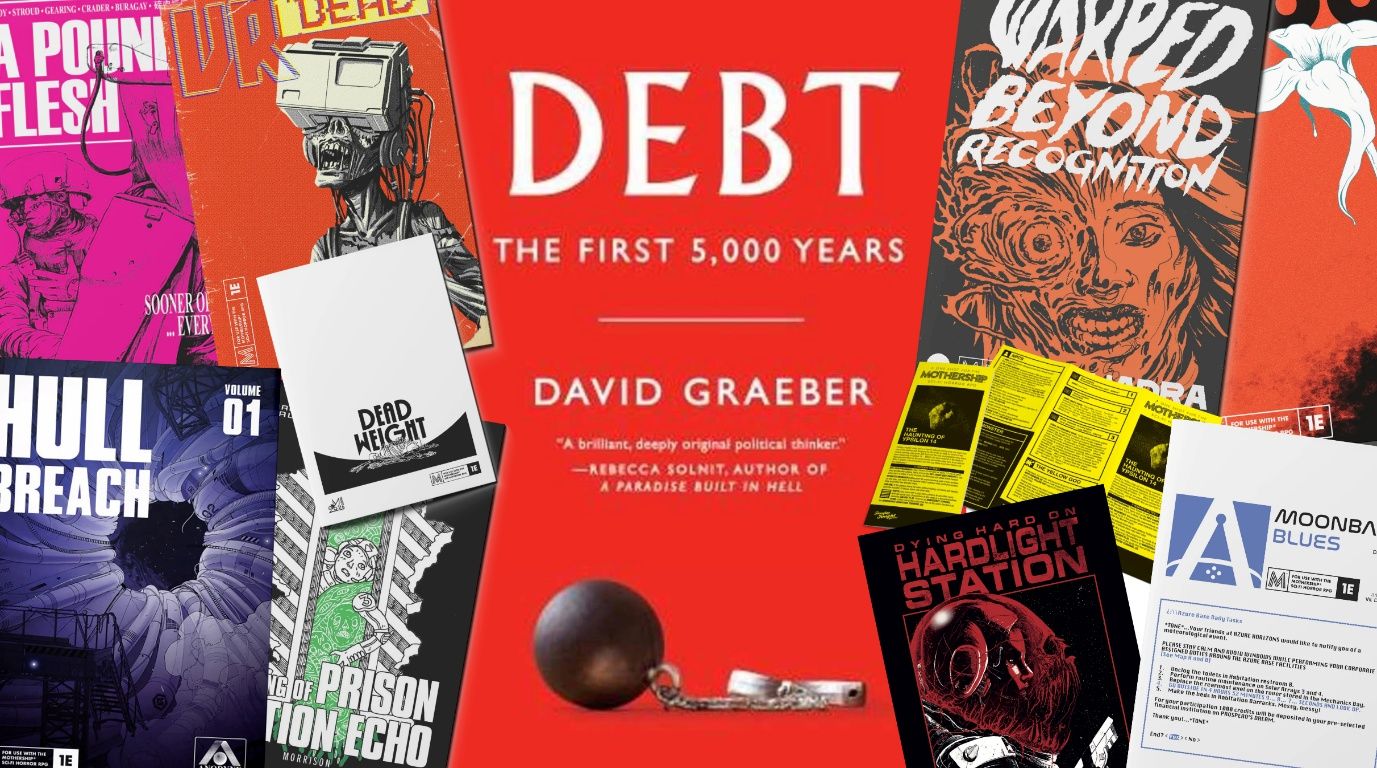
I have many pamphlets but I must campaign: A Mothership table story
Problem Statement
Mothership one-shots are a lot of fun! (enough to make me write a blog post about running them)
…but certain game mechanics (stress, conditions, skill improvements) only play out over multiple modules.
…and people want their characters (including some new classes I’m playtesting) to have arcs that emerge and develop over multiple evenings and a range of scenarios.
…but Mothership doesn’t fit with a typical zero to hero journey. It is a downward curve (or some sort of… Gradient Descent) that may very well end in death.

Most Mothership modules cover one or two sessions and are framed as a job taken on by the PCs. There are of course exceptions — if your campaign is based around larger works like Desert Moon of Karth, Gradient Descent etc then you don’t need this blogpost. Likewise, if you’re carefully building a world of custom content and letting your player’s choices take you in interesting directions then you won’t benefit from any shortcuts.
But if, like me, you have a drawer stuffed full of tri-folds and don’t have the time to write a module every week then you’ll have noticed that the crew are typically either:
a) working a mundane job when something unexpected occurs
b) employed to perform a task telegraphed as dangerous
We can list some example modules for these categories:
a) Ypsilon 14, Screaming on the Alexis, Decagone, Dead Weight, Terminal Delays
b) Another Bug Hunt, Year of the Rat, Iron Tomb, Piece by Piece, Brackish
This is in no way a dig at the system — these two categories are
after all the premise of Alien and Aliens respectively! But it does
present difficulties for constructing a campaign; surviving characters
may struggle to find a motivation to take on another dangerous job,
while a string of unfortunate encounters starts to feel
implausible.
User Requirement Specification
We want a structure that allows characters the chance to improve and even win but more often leaves them desperate.
Characters should have in-game time to lick their wounds, buy equipment and at least slightly improve their skills/saves.
Trends towards keeping/leaving them in poverty, rather than letting them accumulate capital.
Has a chance to cause them more problems. Or at least spark some narrative discussion at the table.
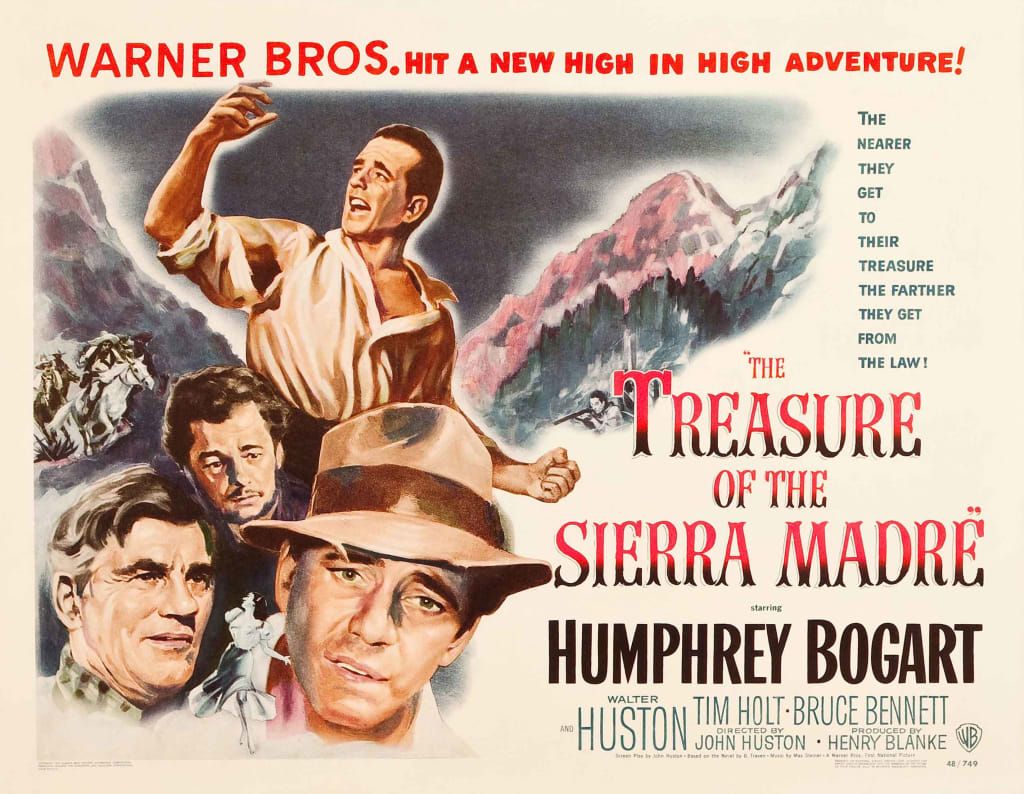 A movie poster with a group of men AI-generated content may be incorrect.
A movie poster with a group of men AI-generated content may be incorrect.
What do the Rules say?
Tucked away on P.53 of the Warden’s Operation Manual, is a suggestion to take 1d10 months between modules, something I missed on my first campaign. This matches well with the rules for skill advancement (2-6 years), especially if we give players the option to go longer until their next module if they’re flush with cash and not (yet) desperate. The section on shore leave (P.39 of the PSG) also includes a handy example of play wherein the Warden is free to offer it at a range of price points in a single location if they think it’s reasonable.
In other words, there’s already a gameplay loop in the published material. Module > Spend Money Recovering/Improving > Module. Everything in between modules could reasonably be considered a Downtime Action and hence narratively flexible. So let’s see what we can add to this:
Addition 1 — Retirement Goal
Drawing from the tables on P.39 of the PSG and P.51 of the WOM we add the downtime action:
Bank Credits. Any port of B-Class or greater typically allows you to upload your credits to a retirement fund. This makes them safe from most forms of theft, taxation, loss etc but also makes them less efficient to liquidate — take a 50% cut on any credits you remove from the bank.
If you reach your retirement goal (minimum of 1mcr) you have the option to leave the freelancer life behind and start a new character. Congratulations! You have won Mothership™, at least until another player beats your high score/retirement lifestyle…
This gives the players a simple end goal, but one that is very hard to reach. And it’s made more difficult by the next new element.
Addition 2 — The Anti-Carousing Table
In the typical OSR gameplay loop, a carousing table represents the characters spending/wasting the vast sums of gold they’ve appropriated in their latest delve. Tasteless statues, drinking binges, donations to temples… d4caltrops has a good one here.
But that doesn’t quite fit with Mothership. This is setting that is about the grind, the corporate dystopia and the random events that can leave our once prosperous freelancer in a perilous situation.
If we assume that a PC who has survived a typical Mothership module is, at best, calculating the risk/reward of another one (and more likely avoiding it as long as possible) then there is no question of “wasting” credits. They will be easily spent on shore leave, retirement (see addition 1 above) and skills. We need to add some flavour to downtime and generate a risk of losing more money, but not a guarantee. Remember that not everything has to be strictly financial — stress, wounds and loss of equipment still have cost. Thus, I’ve written a d100 table where most of the results are credit loss or gaining stress. Example entries are given below.
Your typical week to week employment is enough to cover daily expenses, but will not add anything towards retirement or provide any savings. Whenever time (1d10 months) passes, roll d100 to determine what Life Event has happened to your character in this period of time.
04 — If you have a wound, it has healed naturally on its own. You assume this is just good luck and the passage of time, and choose not to check your rations.
16 — You help out a Contractor in a tight spot. Randomly generate them (P.41 PSG) and gain their services for free on the next module.
25 — Your last five packets of Astroids™ are all chocolate and have no crunchy caramel centres. This is the most interesting thing that has happened to you in this time.
33 — You are offered 1d10 x 10kcr for the data and rights to your complete genome.
42 — A random item in your possession is declared contraband and confiscated by the authorities.
57 — You are harassed by reporters and private investigators about a previous job. Increase minimum stress by 1.
61 — You find yourself at a high stakes’ poker game. Too high if you’re honest. Pass a Fear Save or lose 2d10kcr.
78 — Inevitable, unavoidable taxation. Lose 3d10kcr.
80 - The isolation and loneliness cause you to crack. Double your stress then gain 1 additional stress for each wound and/or condition you have.
99 — Following a crash landing, you are trapped for several days before being found. Gain 1 wound and 1d10 stress.
Note that if the crew has the resources, they can choose to let time pass multiple times to advance their skill training (or simply to push their luck on the above table).
But what happens if random costs like shore leave or those in the table above take characters into the red?
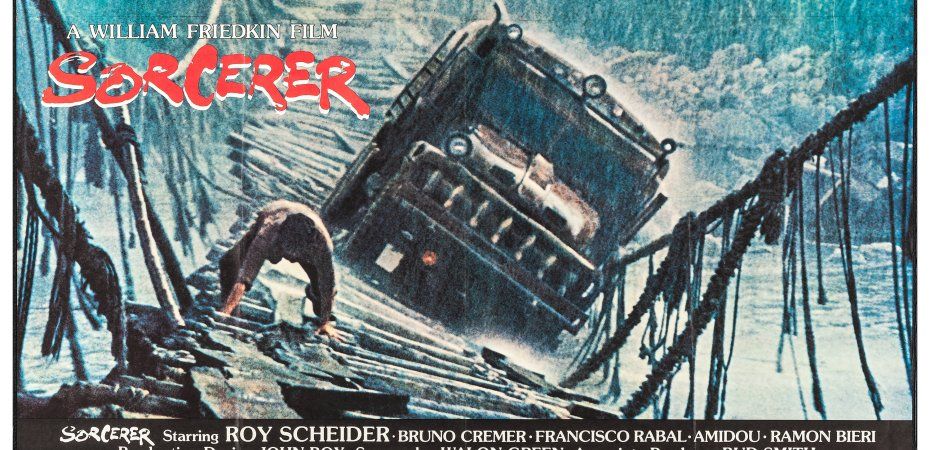
Addition 3 — Debt: The Ultimate Motivation
Mothership already has rules for debt (P.50 WOM) and plenty of people have worked on fleshing this out already (like this blogpost from Jack Shirai). This is just a simple adjustment to keep things moving in an interesting direction while minimising bookkeeping.
Debt is a constant, lurking fear in the world of Mothership. Unlike the other horrors of the rim, it cannot be contained by a steel bulkhead or decontamination protocol. Freelancers talk in whispers of the methods of payment — simple violence is one thing, but then there are the VR customer service roles where every shift lasts a year, live memory extraction for android personality construction, or hosting a portable research bio-reactor between your stomach and kidneys.
If your character ever drops below zero credits, do not record the negative balance. Instead, your character is now filled with purpose to clear the debt and avoid gaining more of it. The Warden will tell you whether a job offers enough to do either of those things, and whether there are any additional objectives that will earn more.
This may lead to situations where characters have secret objectives, benefit from the deaths of other player characters or generally take more extreme risks. As such, it should be discussed out of character via any safety tools/Session 0 being used at the table.
Wardens — remember you can always hand a player a blank scrap of paper with “Secret Objective” written on it if you don’t have any specific ideas. Suspicion from the other players will likely produce something interesting.

The Full Downtime Procedure
After a module has concluded, and assuming the crew can reach a place of relative safety, perform the following steps:
Restore HP to maximum and pay surviving crew members. The Warden may call for rolls and/or make rulings to cover unusual payouts. For example, an alien artifact may need an Intellect check to determine the time to sell and sale price achieved.
Perform any number of the following; Shore Leave (Warden determines what classes of Port are available), Buy/sell equipment (Warden determines if anything is hard to obtain), Medical Treatment (Warden can rule on procedures not covered by the PSG), Skill training (all costs are paid upfront).
Advance in-game time by 1d10 months. Each player rolls on the Life Event table.
Start a new module* or return to step 3 unless a character is in Debt. At the Warden’s discretion, some or all of the opportunities in step 2 may also be available.
Making Alternate Mothership Classes

Generating playtest material for an existing game can often simply involve deriving the designer’s framework and then iterating on it.
After a first run at a Mothership campaign last year (commencing with Lair of the Space Lamb) I’m gearing up for another one later this summer. As before, this will be a “semi-open table” based around pre-written modules (including a couple of my own, but the starter will be Norgad’s recently released Brackish).
Unlike last year, there will be some effort to create a loose narrative framework — but that’s a subject for another blog post. I’ve written some alternate Panic Tables, sketched out a couple of small modules and but today I’ve decided to broaden the character classes on offer.
But why?
It continues to surprise me that there’s relatively little hacking/expanding of the Mothership system itself, in contrast to the vast number of excellent, imaginative modules (both first and third party). There have been some examples of this sort of thing of course, such as Octopus Ink’s Rimward Classes (which I’ll likely also offer as an option to my players).
But more than that, I find this sort of exercise helps me understand why design decisions were made, which in turn sharpens my own abilities. This is why I use the word expanding rather than hacking — all of this is intended to work with, adding options to Mothership rather than replacing or changing parts of it.
Anyway, onto the classes!
Biologics
Clones and other flesh constructs. Rarer than Androids, there is nevertheless a demand for carefully grown and calibrated organic sentience. This might be for security reasons, an environment uniquely hostile to mechanical lifeforms or concerns related to [REDACTED – MONARCH PROTOCOL].
+10 to all stats // +1 Max Wounds
Trauma Response: Whenever you fail a body save or take a wound, all close friendly players make a sanity save.
Skills: 1 Expert Skill and a Trained Skill prerequisite. Bonus: 2 Trained Skills
Both Dune and Mickey 17 got me thinking about this, in addition to Gradient Descent. I wanted it to be more general than just “clone” and allow different players to put their own spin on it similar to the Android anti-canon approach. They benefit from increased toughness due to being ‘improved’ over random natural evolution… but that means their reactions (or suddenly visible innards) add a layer of visceral horror to anyone seeing them harmed.
They are deliberately kept as all-rounders (created for a specific purpose) with open skills and high stats… but low saves. We might assume they are naïve and inexperienced, or even expendable…

(Despite being cyberpunk, Netrunner is an overlooked source of potential Mothership inspiration)
Colonists
Some would describe these hardy folks as the true backbone of space. To them, often going years at a time between resupply ships, community is everything. They are farmers, explorers and settlers who are used to making the best of things.
+10 to 2 stats // +10 to 1 save // +1 Max Wounds
Trauma Response: Whenever a close friendly player panics, gain 2 stress.
Skills: Botany, Wilderness Survival. Bonus: 2 Trained Skills
If the teamster is focused around the industrialisation of space, then we have a gap both in the fiction and skill tree for those settling it. I suspect the focus towards the former was to emphasise the hunger for resources by megacorps — with the implication that there are billions of humans off-screen in crowded conditions, separate from the frontier of the Rim.
Hardiness and self-sufficiency gets them an extra wound, similar to Marines but without the combat focus. Everything else is kept fairly general as they won’t achieve the all-rounder stat/save heights of the Teamster, but can still specialise and rely on being tough. Since they’re relying on those around them, they get stressed out as panic spreads through the group. They’re one step away from a space peasant mob after all…
 Doctor Who Project: The Krotons – Movement Point
Doctor Who Project: The Krotons – Movement Point
(Variations on These Guys turn up in every other classic Dr Who story)
Dealer
While Teamsters are the actual labour force of space, there is a smaller group who trade, organise and handle logistics. These are the merchants, the negotiators and the information brokers. Their confidence and informal leadership is useful, until it fails.
+10 Intellect // +20 Fear Save // +10 to 1 Stat
Trauma Response: Whenever you critically fail a check or save, all close friendly players make a panic check.
Skills: Rimwise, Linguistics. Bonus: 1 Expert Skill OR 2 Trained Skills
I played around with various ideas for ‘Executive’ or ‘Officer’, since both feature in Aliens. Ultimately though, I decided that in a world of freelancer characters things should remain less formal (and you can still start with the Command skill by putting a specific flavour on the Scientist). As such, the Scientist is the closest comparison here – a boost to Fear Save is powerful, so I didn’t give them much else and held back on the skills.
The leadership aspect (in the absence of defined skills) then emerges by being more likely to be unafraid, but also trigger a response when they seem to be really struggling. This might need to be just stats or just saves — we’ll find out in playtesting!
 Characters in Star Trek: Deep Space Nine - Quark's Bar
Characters in Star Trek: Deep Space Nine - Quark's Bar
(Still the best example even though it doesn’t work for a human only setting)
Voidborn
Those that have lived their whole lives on ships, stations and asteroids are already starting to diverge from the rest of humanity. This natural adaptation leaves them mentally resilient in the vast darkness, but lacking physical power.
+15 Speed // -10 Strength // +15 Sanity Save // +15 Fear Save
Trauma Response: Advantage on panic checks in spaceships. Disadvantage when on a planetary surface.
Skills: Zero-G. Bonus: 1 Trained Skill and 2 Expert Skills
The Expanse inspiration is pretty straightforward here. Leaning on the long-term effects of reduced gravity feels appropriate in Mothership’s hard sci-fi universe, while the implied evolution/change also fits the horror themes (even if they’re simply another route towards exploitation by those in power). Mechanically, none of the original classes get a speed boost, so that seemed a logical step, as did reducing strength. Boosting saves and skills is perhaps overpowered, but I like the idea of them being educated/experienced due to a hostile environment. The trauma response then fully leans into this idea of a glass cannon - depending on the twists and turns of a campaign, your character might be a penalised or gain a benefit from module to module. Note that space stations and asteroids are intended to give no advantage or disadvantage — a classic example of where you realise just how hard it is to frame rules with a succinct character sheet.
Stepping out of the Spotlight, and other Roleplaying Improv Tips
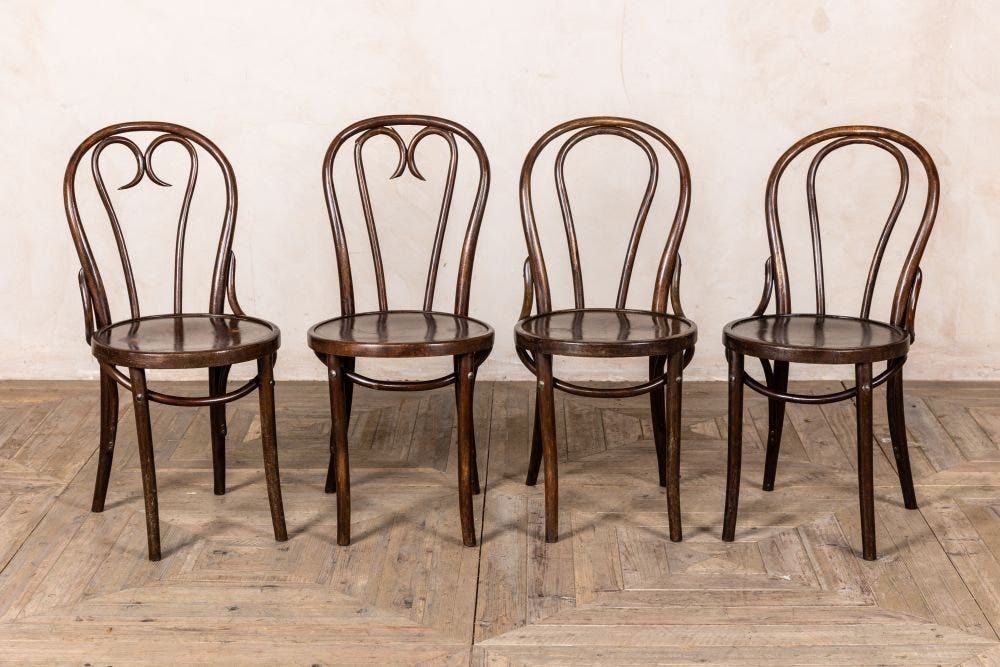
Only one of these is an actual acting tip, and even that is about making it less work for you.
Around 10-15 years ago I did improv once or twice a week for around 3-4 years. This taught me several things:
It’s about the right amount of time to be really invested in it.
The most accurate depictions of improv in wider media are, in order, a) Don’t Think Twice (dir. Mike Birbiglia, 2016) b) SE1E06 of Broad City c) the ‘improv as Scientology’ plotline in Season 2 of Bojack Horseman.
Most people will go on to use what they learn in things other than improv.
Notably, there is a lot of improv/tabletop roleplaying game crossover (even from performers who have made far more money on the West End than they ever will via improv or ttrpgs).
So here are three miscellaneous tips. This isn’t an exhaustive list by any means, but they are the things I use the most, and I was inspired by Prismatic Wasteland on Sharing the Spotlight to talk about the final tip in particular.
The OSR Lethality of Hamlet
Tell a group of beginner improvisers (or, horror of horrors, your colleagues at a team building exercise) the following “split into two teams and mime a tug of war between them”.
9 times out of 10, here’s what will happen; they will all pull on an imaginary rope… forever. Until prompted, no side will mime collapsing, stumbling over the line in the middle etc. This is because humans instinctively don’t want to lose, even when there are zero stakes and the ‘contest’ only exists because of a shared narrative.
This has a direct application to any ttrpg with high lethality, especially OSR games (horror games are easier because it’s an inherent feature of the genre).
So, here’s how to use this to pitch such a game to a player who is worried about character loss.
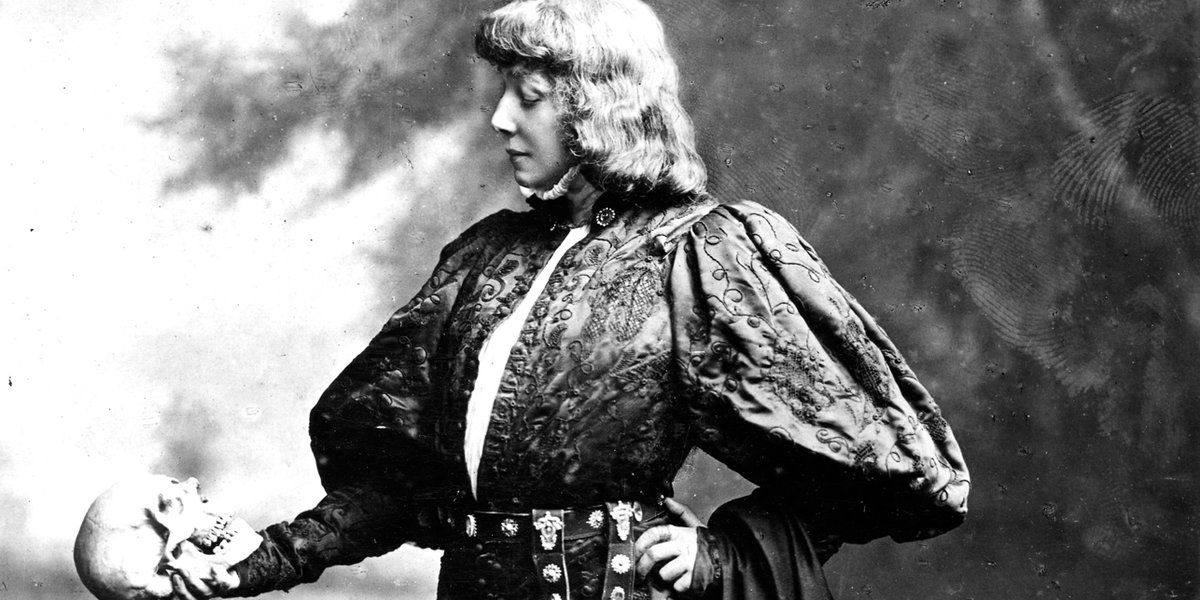
Actors fight over the role of Hamlet, even though Hamlet dies at the end (spoilers). Without accepting that a character may fail, may suffer a reversal of fortune and may, yes, die… there is a lack of contrast with their successes.
Moreover, just like a character may die at the end of a 30 second improv scene, the death of an rpg character is simply a reason to bring in another character from a literally infinite pool of potential PCs.
Thus, we can conclude that your character dying does not mean you are playing wrong. You are not letting down other players, and you are not failing to parse the rules. It is simply the fate of some characters.
Speaking styles, not accents
A decade of actual play streaming, videos and podcasts has put a lot of pressure on GMs to emulate professional voice actors or other performers. Now, even though I don’t play or run trad/OC 5e any more I haven’t stepped fully into ‘immersion is bullshit’ levels of indie-ness. I think there is absolutely a place for speaking in character, provided it’s something the table is comfortable with and you’re aware that invariably slows the pace of the narrative.
But what I am interested in is efficient acting. That is to say, how to get the most benefit from the least skill and effort. And that benefit isn’t just surrounding everyone in the room with a richer narrative environment, it’s practical things like differentiate NPCs from one another and making them memorable.
So, don’t worry about accents — think about the way people speak. Slow? Fast? Do they have a stutter or other verbal tic? Do they use simple language or flowery metaphors? Are they constantly referencing their faith or other beliefs? Are they snobbish or overly friendly?
What you’ll often find is that an accent of a sort develops naturally from these prompts, and it will help you memorise and build them as characters as well.

To quote a former improv teacher “every Coen brothers movie has at least half a dozen characters who speak in distinct, memorable ways and these are pretty easy to steal”
Stepping out of the Spotlight
This one is as simple as it sounds. GMs are (correctly) told to ‘share the spotlight’ between player characters, to make sure not only that the narrative doesn’t default to the most vocal player, but that the action economy doesn’t collapse in absence of a defined initiative roll or equivalent.
But if you’re the player — you can give the spotlight away.
Looking for ways to do so is a great way to help players that are unfamiliar, anxious or unengaged (within reason — don’t pile on the pressure!). And it works both in and out of combat. You can:
Rule yourself out of scenes — ‘my barbarian will play dice in the tavern while the rest of them go to the library’
Ask for help — ‘Can Grommir help distract the ogre so I can smack it in the head?’
Prompt someone to lead — ‘As a druid, I know nothing of the city streets, can Blackwing guide me to the correct alley for the deal?’
Offer help to others — ‘If I make myself big and imposing to distract them, someone else can take advantage of that’
Take a passive action — ‘I stand guard while the rest of the party examines the corpse’
Quantum Languages for Basic D&D
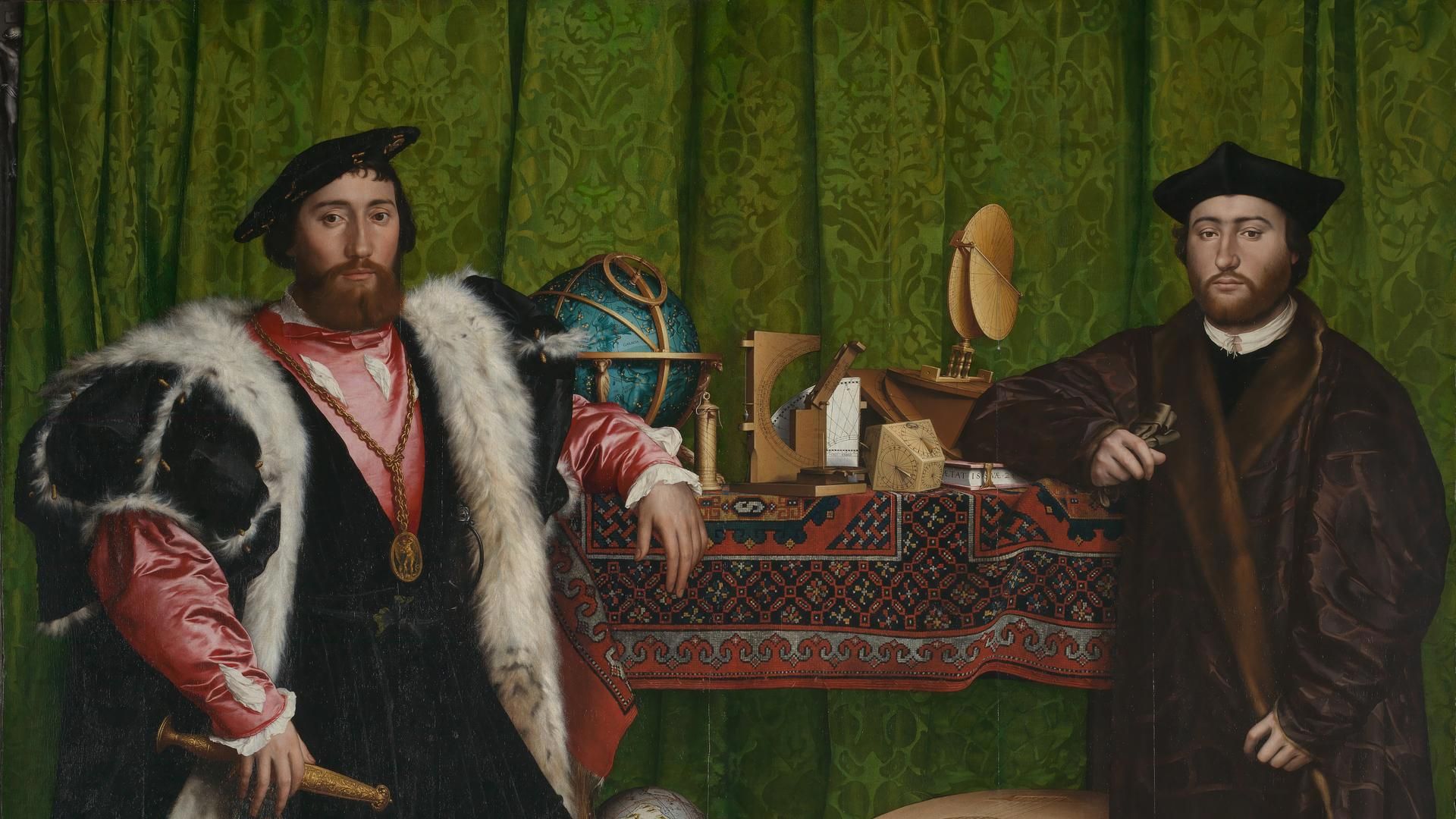
Or, testing your character’s skill as an ambassador only when there is something at stake.
As my Mothership boxset goes into cyrosleep for a few months while I work on some modules and supplementary pamphlets, it’s time to look ahead to what I’ll be running in the new year — a first playtest of a Black Wyrm/Ragged Hollow town sandbox using Old School Essentials. I absolutely should be fleshing out the treasure tables, writing some small dungeons and giving the NPCs more than Priest (Nervous).
But instead, I got distracted by languages.
More specifically, some recent Discord conversations reminded me of Prismatic Wastelands Quantum Languages (which itself references several other posts) and made me aware of Dungeonfruit’s Thirteen Tongues (Making Languages Interesting). These are both great, and I’ve previously playtested a less developed version of Prismatic’s rules in my own system.
However, we’re dealing with the strict retroclone here, the B/X, the Red Box — so how do we work something simple into that framework?
The Goal
We want something that’s easy for the players to understand and leads to interesting outcomes. Taking a little time to resolve any procedure isn’t too much of an issue, because these rules won’t be coming into play all that often. Overall, choosing to use this should be beneficial much more often than not, because we want players to both take risks and try to interact with spoken or written languages to generate a richer experience.
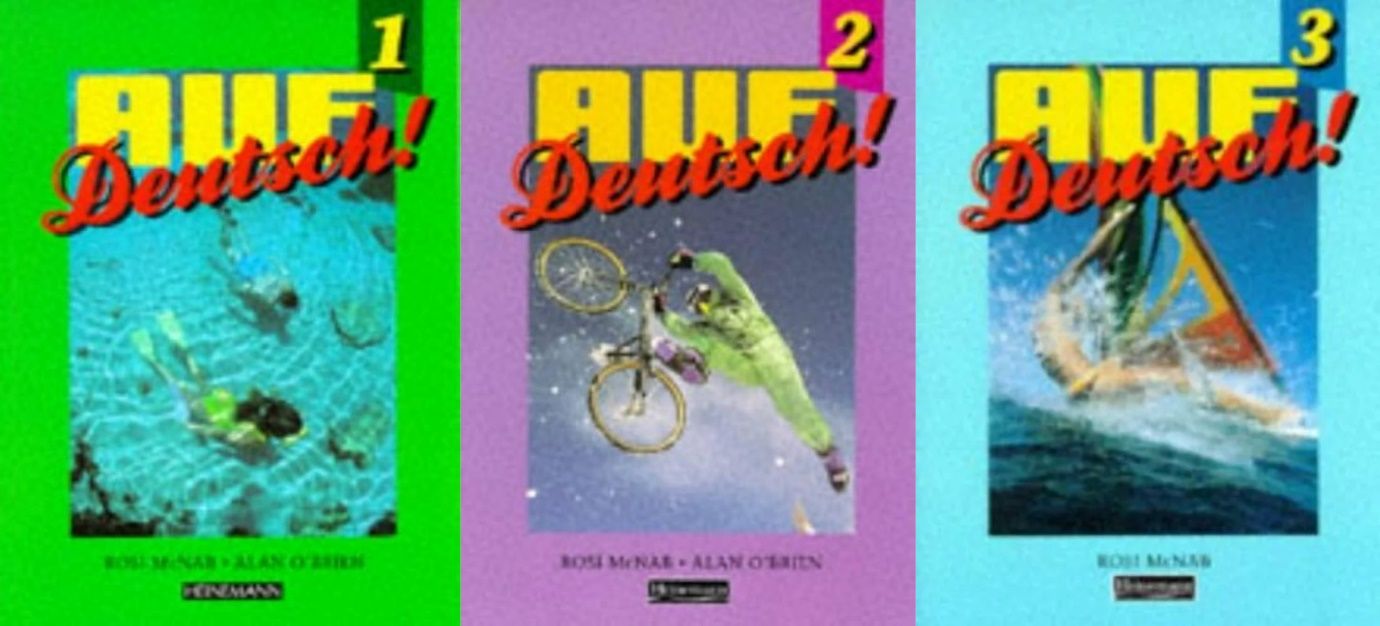
For example, my B in GCSE German means I have crossed the country via snorkelling, mountain biking and windsurfing.
So we need:
Multiple degrees of “language success” and “language difficulty”
A resolution system that provides that level of variation in outcome
Terms and conditions for when you can deploy the procedure
The Development
Interesting levels of success in languages are pretty easy to imagine; fluency grants a bonus, and lets you explain complex ideas (no need for rules around that — it’s implicit by the use of the word fluent). At the other end of the scale, miscommunication naturally gives rise to all sorts of farcical situations — even when traps are involved.
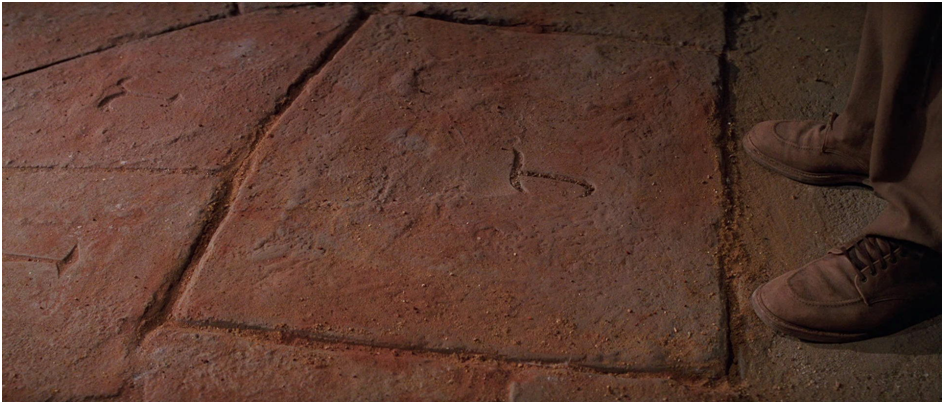
In between those two extremes, we can offer various bargains such as being able to read a language but not speak a word. And the more widely spoken or accessible a language is, the easier it is to pick up.
For resolution, we could look at a roll under ability score, but I think adapting the Reaction Roll itself (or at least the 2d6 bell curve) gives us a better representation of typical languages. You’re seldom terrible or brilliant — mostly it’s just how much effort you need to put in and how articulate your vocabulary is.
Then, the whole purpose of this procedure is that you only apply when something is actually at stake. Again, both the Reaction Roll and a classic Saving Throw are our guides here. If you hear about the Temple of the Goblin King, do our adventurers research the local Goblin dialect and customs? Of course not — they aren’t some sort of nerd, they want treasure and they don’t want anyone else to get there first.
The Procedure
Caveat: These rules assume Alignment Languages are not being used, because having essentially four languages (Common + 3 alignments) in the world renders this exercise a little pointless.
All player characters begin play knowing The Common Tongue. They also have language slots equal to 2 + their Intelligence Modifier.
Non-human races must fill a language slot with the tongue of their kin on character creation. They are automatically fluent in this language.
Characters with other languages available (e.g. Gnome for Dwarves) may fill slots with these during character creation. These are also considered fluent.
In play, a character may declare they are filling an empty language slot if:
This character has not encountered this language before.
The language is present and can be interacted with. E.g. it is available in its written or spoken form, be it via an NPC, a book, a magical recording etc.
Roll 2d6 + Charisma Modifier on the following table, also applying a further modifier for the difficulty of the language:
Easy (+1) this language is simple and widely used.
Standard (+0) used only by specific groups day to day, but follows typical structure.
Difficult (-1) obscure, unusual ways of speaking by small populations
Extremely difficult (-2) dead languages with no native speakers, the secret tongues of cults and spies.

Note: Referees may apply some discretion to both “has never encountered this language before” and the difficulty of the language. For example, if a character declares that they wish to use some downtime to study a previously encountered language, this should allow them to make a roll when they encounter it again.
d10 Emergent Transgressions
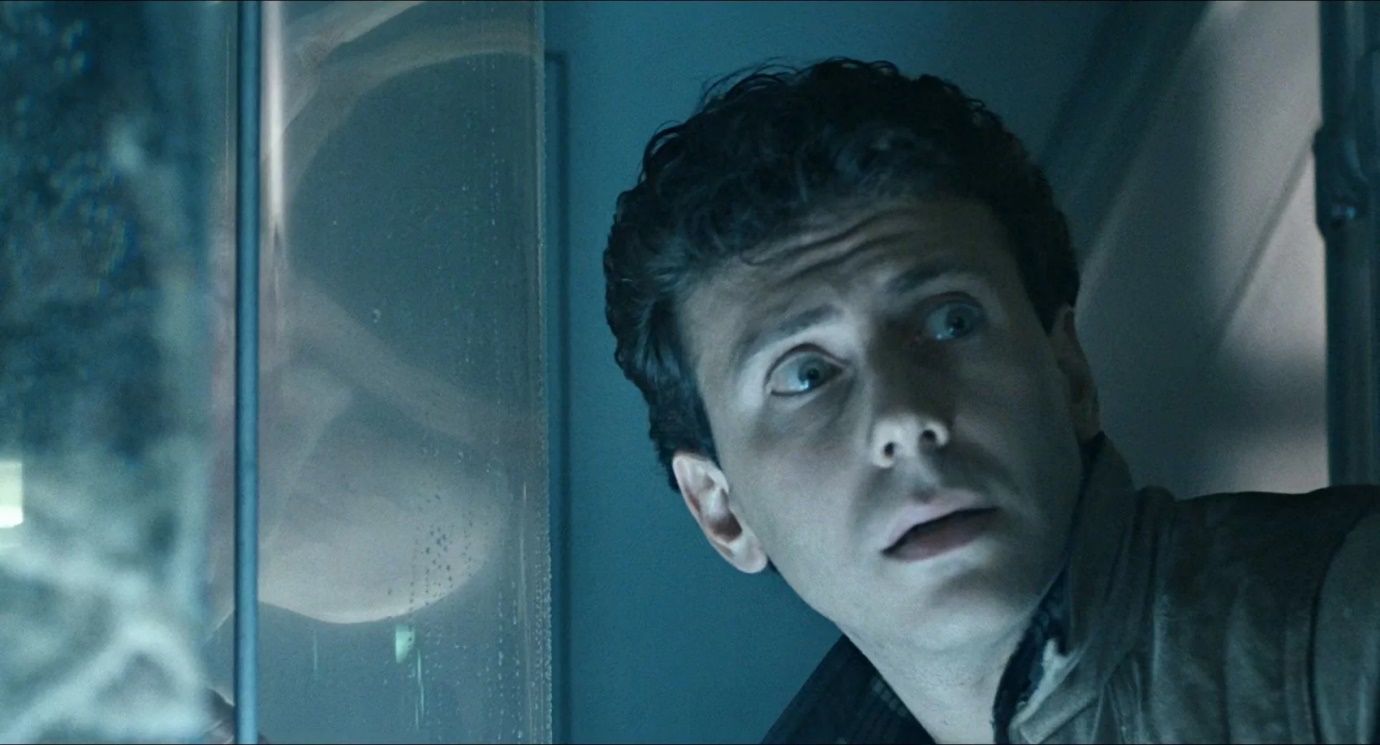
Or, giving your players a key to the TOMBS
I’m going to get the second half of the title (and the subheading) out of the way first. The Mothership Warden’s Operation Manual gives us a handy checklist called the TOMBS Cycle (Transgression, Omens, Manifestation, Banishment and Slumber), and we’re interested in the first step.
Transgression
Someone knowingly or unknowingly awakens the Horror from its slumber. Horrors occur because at some point a line was crossed that wasn’t meant to be crossed… Transgressions can be active like deciphering the runes on an ancient relic, or passive like docking at a backwater spaceport… Usually, your players only realize that they have Transgressed by the time it’s too late
The whole cycle (and the full description I’ve paraphrased above) is well worth reading. But something I’ve noticed when looking at the popular Mothership modules is that the transgression has often already occurred, and the PCs are simply either a) taking on a dangerous but thinly detailed job b) in the wrong place at the wrong time. In either case, they are not the transgressors.
And to be clear, these are both great. I have run and written modules with this exact premise (indeed Lair of the Space Lamb is THE classic OSR funnel example of b). It is extremely fitting for the game’s blue collar, corporate dystopia themes that you are caught up in events outside your control and/or have no choice but risk your life for a paycheck.
But not all crews are simple Ypsilon-14 package collectors…

(or my personal favourite fan tweak to that module - vending machine restockers)
Emergent
What if that poverty-stricken desperation led to some interesting choices? The players are already vulnerable to temptation, all they need is something to tempt them. You could dangle risky opportunities in front of them, but I think that stumbles a little in Mothership because every job is so risky. So my approach is objects. After all, is it not the Xenomorph egg that birthed this genre? There’s even an example in the Player’s Survival Guide.
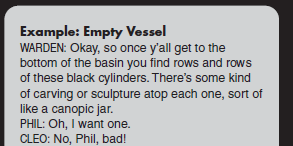
Note however, that this example of play (p.36 by the way) gives the players immediate consequences for that action during the module. Again, this is probably the most common approach - it’s the premise behind (very good) modules like Iron Tomb for example.
But here’s where the emergent comes in. If we’re in a campaign, we want the player’s actions to create problems over time and have them combine with other modules and other player choices in unexpected and delightful ways.
Building your Objects
There are two main sources of OSR inspiration here:
Cursed Magic Items. An object that provides a rare or unique benefit, but comes with a price that may range from inconvenient to fatal.
Complicated Treasure. An object with no utility except tremendous value, but which is difficult to own, transport and/or sell. (Something I’ve already written about)
Temptation can therefore be either because it’s useful, valuable or both. The “price” can be from the risk of the object itself and/or how the wider world reacts to you owning it. And the transgression may be simply the passage of time, using it (or using it too much, in defiance of a moral code etc) or other groups become aware of it.

Do not transgress it after midnight
I have put 10 examples below, but first…
A Note on Guilt
To what extent do we want our horror tabletop rpg characters to be responsible for their downfall? There is of course no correct answer, but you can generate some interesting shifts in the tone of a campaign this way. The arc of victim of circumstance > greed > downfall is an interesting one to play out. Note that this can result in player conflict so be prepared to discuss that appropriately out of character.
But what an amazing character exit, eh? Risking everyone else when you try to make a profit, pitching the remaining PCs (and the new one you’ve just rolled up) into an entirely emergent scenario.
d10 Emergent Transgressions
Just an ordinary rucksack full of expensive (100kcr) drugs. However, the handover has to take place on an abandoned station, to make it easy to check you aren’t being tailed or scanned from a distance.
Some spotlessly clean stimpacks with colourful but blurry packaging, similar to one of the major medical corps. You’d have probably died without it, but now you feel strange. As if whatever copied this item didn’t fully understand what it was meant to do.
A rugged and reliable smart gun. It has a personality. It will tell you whether this target deserves it. If not, it will suggest others.
Keycard (Red). Comes with co-ordinates to the long lost ‘Phobos Hanger’. It also disables the sentry guns on the approach, allowing you to fly straight in - whoever created the cards needs an intact ship to escape in.
Alien art statue (250kcr), like a swarm of bees frozen in liquid nitrogen. It evokes nothing in you, but collectors have been known to kill for it, sometimes while the auction is still in progress.
Ship cloaking module - impossible to buy on the open market. When you use it there are shadowy figures in previously empty cyro tubes.
Synthetic spaniel, very loyal. Immortal, desired by many, wails mournfully if not walked.
Malthusian model C food dispenser (discontinued). Quadratically duplicates food and drink offered up to it. The off switch is unreliable.
A coupon good for one job undertaken by Sirius T Xanex, eminent bounty hunter. Using Sirius will only encourage factions in this sector to militarise further. Your subsequent jobs may have more obstacles.
Android spare parts, enough to heal wounds and even replace missing limbs or digits. They were taken from condemned androids who turned against their masters. These robot hands will kill again.
How I run Mothership One-Shots
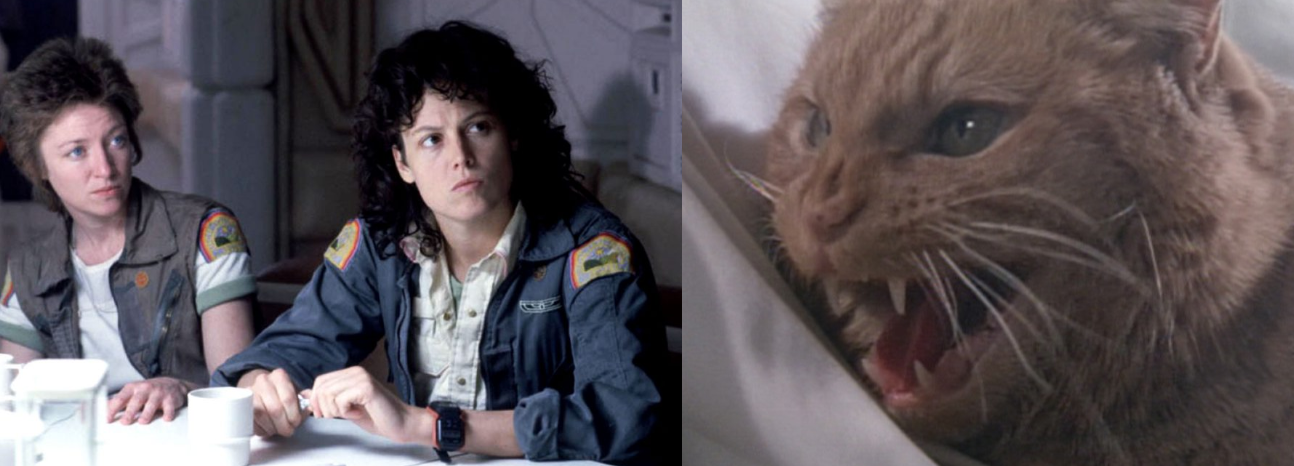
Or, making your player characters more Ripley and less Jonesy.
I’ve had a Mothership-heavy few months; finishing up my campaign (which started with Lair of the Space Lamb) then running a couple of playtests for a module I’ve written. I’ve also watched both Alien and Aliens for the first time in a decade, as my wife wasn’t sure if she had ever seen them (she had not, prompting the memorable line, shortly before Ash’s betrayal, “is Bilbo an alien!?”)
The second of the playtests was at a mini-convention here in Bristol for the Apocalypse Players podcast, thus casting me as the lone Mothership Warden in a Deep One-infested sea of Call of Cthulhu Keepers. I had three players, all very keen to try out a game they had heard about but not had a chance to play.
And then something interesting happened. I got one of their characters to 20 stress.
This is the first time I’ve done this in a one-shot, and it was achieved without using any optional rules (more on those later).
So I thought I would write up how I ran the game, how I frame one-shots in general, and why I think it delivers a good player experience. There’s also some parts about how my thinking on Mothership has evolved since I started using the 1e beta pdfs early in 2023.
Tweaking the Loadout
The only choice you make in Mothership character creation is selecting 1-4 skills depending on your class, and you don’t see a huge amount of stat or save variation outside of class bonuses due to the 2d10 bell curve.
This leaves us with equipment, where I agree with the WOM (Warden’s Operations Manual), to whit:
Rolling random Loadouts helps reduce shopping time before a game begins, and also creates a situation where players don’t have everything they need at hand and must work together.
But I think the actual Loadout tables in the PSG (Player’s Survival
Guide) are too variable to fully support this. The aim, at least to me,
is that everyone ends up with a few different things, of which some are
obviously useful, some are weaker/less applicable than you would like,
and some appear (at first glance) to be completely useless. The PSG
provides entries like these:

Highly variable, but also 1. We aren’t giving the marine anything more than a gun and some armour. 2. The person who rolls ‘well’ has nothing to readily give/lend the person who rolls ‘poorly’ to balance things out. I do understand that these results imply something about the character’s circumstances and background - but we have the trinket and patch tables for that (and they’re great - always roll on them!).
I’ve experimented with a deck of equipment cards in the past (which made for a fun one-shot of Screaming on the Alexis, as I woke them up from cryosleep and sent them scavenging) but my most recent approach is just to create a new series of tables for everyone to roll on that is tailored to the module at hand. For example, for my playtest:
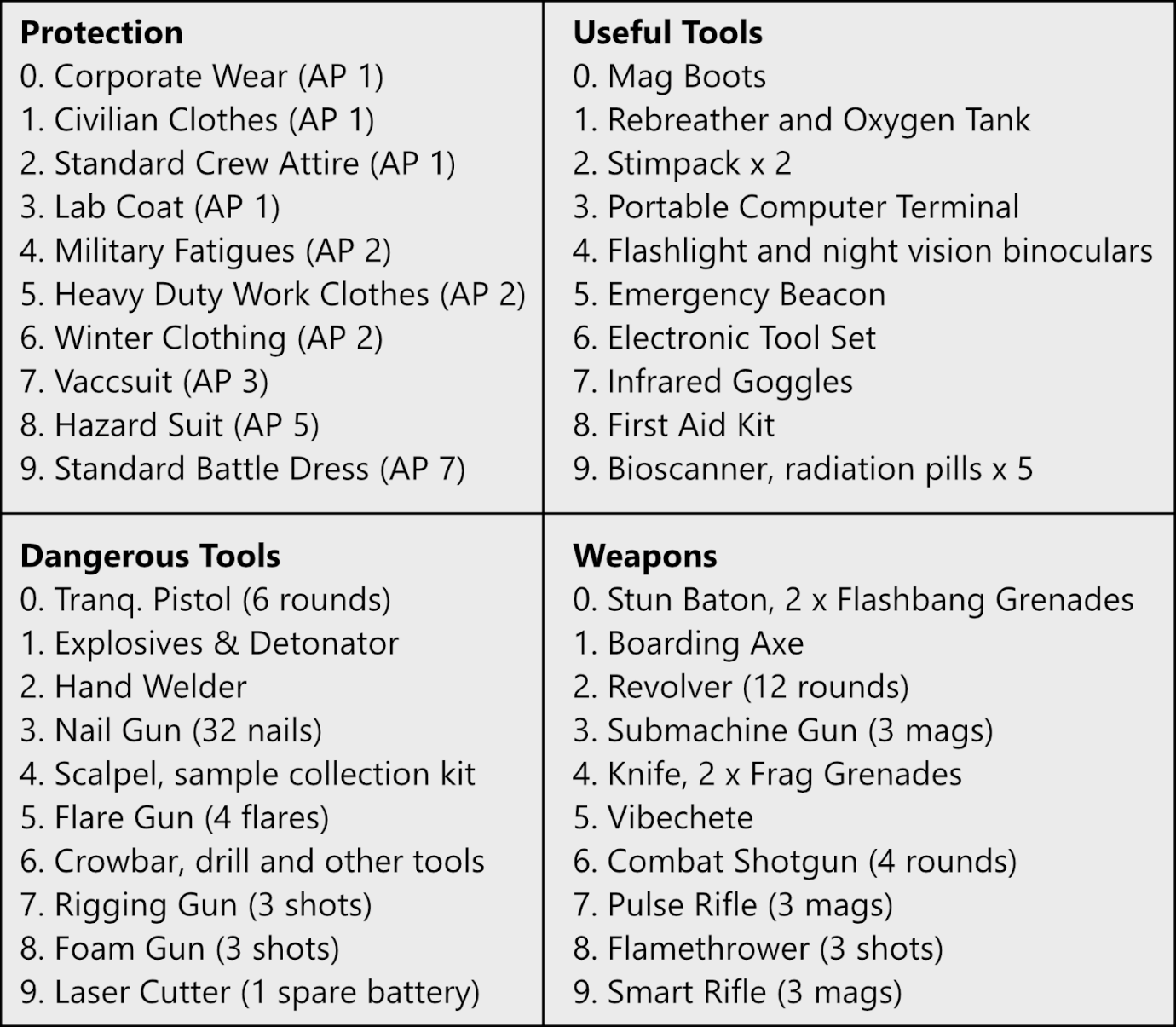
You can have everyone roll once on each table, or mix it up to give 4 rolls in total. If you want less powerful PCs, limit the number of rolls or roll 1d5 instead. Almost certainly needs further refinement - but the idea is to give them a few things they can start thinking about how to use, ask questions about, describe for their character’s appearance etc.
And all that gear? It just might make them overconfident…
Establishing Questions
– Did you ever ship out with Ash before?
– I went out five times with another science officer. They replaced him two days before we left Thedus with Ash. Hm?
– I don’t trust him.
– Well, I don’t trust anybody.
Something that Quinns Smith mentioned in both his Youtube review and interview on the Bastionland podcast was the lack of rules or guidance around bonds/relationships for PCs. In a campaign (where the WOM section on framing/prepping is very good), these might emerge over time and/or be determined in Session 0*, but for a one-shot we need a shortcut.
Enter Trophy Dark and Jason Cordova’s blogpost about Establishing Questions
I won’t repeat what’s written there, only to say that the first section (General Establishing Questions) is particularly appropriate. We, as the Warden, know what module we’ll be running in advance but not the specific player characters that will be involved (unless you’re using pre-gens, which I’ll talk about below). Thus, for Haunting of Ypsilon-14, we might go around the table and ask:
Who do you know onboard the mining base? (You can then easily amend one of the existing NPCs)
What’s something you always do as soon as you aren’t cooped up inside the ship? (Hopefully someone will check out the shower)
What spare parts does the ship need that might be ‘lying around’ in a mine? (this could even be a reason to delay their departure)
Why do you care that there’s a research vessel docked in the other landing bay? (very open-ended this one, but your players can often surprise you!)
When have you promised your friends or family that you’ll be back from this job? (sentimental yes, but helps underline the blue-collar themes of the module)
There’s a couple of other tools that I’ve used but bring out only in specific circumstances:
Pre-generated Characters. I did use these at the convention (but made two of each class) just to save as much time as possible but generally I prefer people to generate their characters. The sheet makes it so straightforward and it helps teach new players that it’s not the end of the world if a character is lost.
Secret Agendas. I prefer these to emerge out of the Establishing Questions - partly because it lets me check in with the players about the concept but mostly because players will be much more invested in agendas they think of themselves and pass across to me on a scrap of paper.
So give them some stakes and goals. Build those little inter-PC rivalries and status games. It only takes 5-10 minutes but absolutely pays off when they’re making tough decisions 2 hours later.
(*Something I’d like to write or have someone else write for Mothership is a “Session #0 Standard Operating Procedure”. You could present it as an in-game document in a manner similar to Breach of Contract and also include some lines and veils as well as a ‘what is an Android?’ section)
ABS. Always Be Saving.
Space is deadly. You just won’t believe how vastly, hugely, mind-bogglingly deadly it is. I mean, you may think it’s deadly to jump in the hippo enclosure and try to steal Moo Deng, but that’s just peanuts to space.
(With apologies to Douglas Adams)
Pages 22-23 and 32-33 of the WOM talk a lot about rolling dice, they say things like:
Roll as little as possible.
What the player wants to do, they usually just do. Opening doors, talking to people, even violent actions like attacking someone, often won’t require a roll.
You typically only roll dice when it is both unclear what would happen and the stakes are high. Tell them they can think of their Stats and Saves as a measure of how good they are when unprepared and under extreme pressure.
Avoid rolling: 1. When the stakes are low. 2. When it’s obvious what would happen. 3. When they have the right tool. 4. When they have a good plan.
Now, as a former 5e DM and member of perception-rollers anonymous I think this is really good advice.
Well, I think it’s really good advice for stats + skills.
But saves… saves are a little different. And the reasons are partly thematic and partly because of the game engine.
Saves get less attention in both the PSG and the WOM. And I think some of what is said above with respect to rolls applies primarily, or even exclusively to stat checks specifically. For example, page 33 of the WOM gives us a whole table of (really good) examples of how failing a roll can advance the shared narrative in lots of different ways other than “the intended action doesn’t happen” - but all twelve examples are stat checks.
On saves, we’re told:
You have three Saves which represent your ability to withstand different kinds of trauma.
Saves are reactions, rolled to avoid different mental, emotional, and physical dangers.
However, with the main source of involuntary PC behaviour actually being the Panic Check, sanity and fear saves in particular are often just a roll to avoid gaining stress. And honestly? It totally works in my experience. We don’t need Sanity Saves to give us the sudden swings of madness you get in Call of Cthulhu for example - where Mothership excels is the steady ticking up of stress, the small roleplay moments from a failed save (new players really take to this in my experience). You can still get an unexpected panic check from a critical failure after all.
That quote I butchered above? It’s to show that unlike stat checks, rolling lots of saves in a Mothership one shot is entirely thematically appropriate. These characters are having the worst day of their entire lives. It’s not like you make one Fear save against the killer robots and if you pass you’re never afraid of them again. The swirling strobe patterns on the vidscreens aren’t meaningfully less insanity-inducing the second time they appear.
And also… the game works better once the PCs are at like, 6 stress or so. It just does.
At that point, you have a 30% chance of failing a panic check AND the results on the table become more interesting. To get the really dramatic ones like Doomed or Catatonic you need 10 or 15 stress respectively. These are the results that have pivoted the entire narrative of one shots for me in the past - you want them to be an emergent possibility!
I should note that page 8 of Another Bug Hunt suggests PCs gaining 1d5 stress on a failure for a one shot, and the PSG mentions that it’s sometimes appropriate to give out stress irrespective of a roll. Both of these work to accomplish the goal of a higher stress gain - I’m just happy to have my players rolling saves more often.
So use those saves to build stress and emphasise just how bad this world is. Attach saves to evocative descriptions of sights and sounds, to moments of narrative revelation. Give the tension of the stress mechanic a chance to prove itself when a critical failure is rolled later on.
But what does this have to do with Alien (1979)?
“Cats will amusingly tolerate humans only until someone comes up with a tin opener that can be operated with a paw.”
― Terry Pratchett, Men at Arms
Jones the cat serves mostly as a way to get the human characters into trouble. He possesses little in the way of specialist skills, and the affection the crew have for him is seldom reciprocated. He doesn’t drive the action, and ends the film much as he began it.
We don’t want that from our PCs. We want a Mothership one-shot to produce one or more Ripleys, characters that:
Engage with their surroundings using both intelligence and curiosity
Are seen to be psychologically impacted by events that unfold
Have varied (and tested) relationships with those around them
Use a variety of equipment at key moments
So go forth and make those Ripleys - and give every PC the opportunity to become one. Establish their stakes in the world of tonight’s one shot, give them an assortment of tools to play with beyond their bare hands and let them get stressed. They will reward you with their own secret agendas, desperate gambles for wealth and survival, risky plans and heroic rescues.